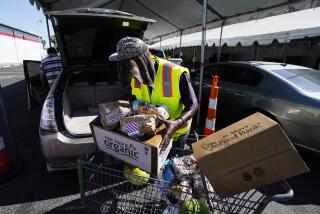Farmers Get Loans but Crisis to Continue : Many Still Have Massive Real Estate and Equipment Debts
- Share via
WASHINGTON — All but about 5% of the nation’s farmers are getting the loans they need for spring planting, according to key agriculture and banking officials--far more than the number predicted when President Reagan vetoed an emergency debt relief bill last month.
But, although banks and government lending agencies are sticking with farmers this growing season, a long-term crisis centering on massive real estate and equipment debts still threatens, according to Undersecretary of Agriculture Frank W. Naylor Jr. and representatives of the American Bankers Assn. and the Independent Bankers Assn. of America.
Record Planting Possible
“It appears that most of our farmers have received operating credit this year, and, indeed, planting intentions are at record or near-record levels,” Naylor told the Senate Banking subcommittee on financial institutions Friday. But he added: “This does not minimize the longer-term problems that were there before.”
Of the nation’s 2.4 million farmers, 420,000 are considered “financially stressed,” with their debts equaling 40% to 70% of their assets.
On Wednesday, Naylor testified before the Senate Agriculture Committee that about 5% of farmers would be unable to plant because of failure to obtain credit for fuel, seed and fertilizer--a figure in sharp contrast with the forecast of 15% made by some farm economists last February. Historically, the rate has been about 3% to 3.5%.
“The truth is,” Naylor told reporters after testifying, “the lenders in the end went ahead and stayed with many of their farmers. They’re optimists.”
Agreeing with Naylor in interviews Friday were Alan R. Tubbs and H. L. (Bud) Gerhart, who head agriculture banking committees at the American Bankers Assn. and Independent Bankers Assn. of America and also run farm-oriented banks in economically troubled Nebraska and Iowa.
“I wouldn’t disagree too much with his 5%,” said Tubbs, president of Central State Bank in DeWitt, Iowa. “But, boy, there’s a current right underneath the surface. If it doesn’t rain, if a good crop doesn’t materialize, then a ton of FmHA (Farmers Home Administration) loans are not going to work and the bank loans that we put on the books for people we’re trying to eke along with are not going to work, and we’ve got a tremendous mess.”
Gerhart, president of First National Bank in Newman Grove, Neb., said: “I’m going along with these guys to the extent I’m not demanding machinery payments that are due. I’m also helping them with the beginning crop expenses on the assumption that Farmers Home is going to come through with their loan application. It’s a gamble.”
Naylor said FmHA, the Agriculture Department’s farm lending arm, will make available $3 billion in direct and guaranteed loans this fiscal year in an effort to alleviate the crisis. That would be nearly double last year’s lending levels.
Loans Called Risky
But Gerhart and Tubbs suggested that much of the lending is extremely risky.
“Around Newman Grove, I’ve found FmHA going full bore to get these people out in the field,” Gerhart said. “I think the political pressures on USDA and Frank Naylor are such that they are going along with some crop loans that to me don’t look like they’re going to work. It’s just postponing the crisis. If we get a drought, we are in deep trouble.”
“We’ve had two in a row now,” Tubbs noted, “and that’s what concerns us.”
In testimony before the Senate subcommittee Friday, Tubbs and Gerhart sought the same kind of federal help for agricultural banks that was given to the savings and loan industry in 1982. But two federal regulators said that farm banks are generally in sound shape and that the government has adequate tools to deal with the relatively small number of problem banks.
Despite a sharp increase in farm bank failures, “there is clearly no crisis,” testified Margaret L. Egginton, deputy to the chairman of the Federal Deposit Insurance Corp. She was supported by J. Charles Partee, a member of the Federal Reserve Board.
“There’s quite a lag in their statistics,” Tubbs rejoined in an interview.
More to Read
Sign up for Essential California
The most important California stories and recommendations in your inbox every morning.
You may occasionally receive promotional content from the Los Angeles Times.













